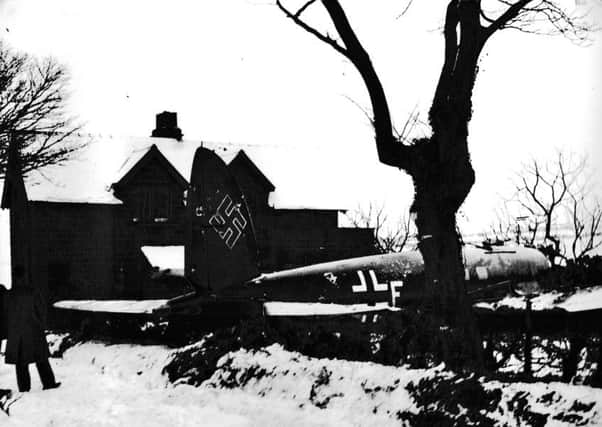German bomber shot down 77 years to day


The Heinkel 111 bomber was blasted out of the sky by Group Captain Peter Townsend, and crashed down at Bannial Flatt, at Sleights road end.
It was the first enemy aircraft to be brought down on English soil in the war.
Advertisement
Hide AdAdvertisement
Hide AdFormer teacher Steve Midwood made a plea in the Whitby Gazette in 2009, asking people to contact him with their memories so he could put a book together – and he was overwhelmed with the response.
Local and former Whitby people got in touch with personal memories and photos which allowed him to bring to life the tragic events of that day in the book First Eagle Down
Among those featured were local man Roy Steele who, as a 10-year-old boy, had been helping with the cows in a byre at Bannial Flatt Farm, heard the ‘rat-a-tat’ sound and was the first person on the scene. He slithered into the cockpit to aid the badly-injured gunner.
He spent the following months collecting souvenirs from the crash site, among them a wireless mast which he donated to Whitby museum.
Advertisement
Hide AdAdvertisement
Hide AdAuthor Steve said: “This book is an attempt to capture those unique personal recollections of a turbulent time, in our not too distant past, a time when the war arrived upon the doorstep of an unsuspecting town. The book is not a commercial undertaking, and I have used it to support Filey Museum funds and I have donated copies to Whitby Museum to aid funds there too.”
He was delighted with the response he got to his plea for more information, which he made in the Whitby Gazette.
“Initially, I thought just one response would make it all worthwhile,” he said.
“However I received a cascade of offers. It is surprising how far the Whitby Gazette travels, I received responses from across the UK, from Germany, and as far away as the USA. I also received information for several years after the request which perhaps reflects the readership of the Gazette online archives.
Advertisement
Hide AdAdvertisement
Hide Ad“The focus of the story is around how ordinary people reacted to these unique events at a local level. I have endeavoured to cover the military aspect of the events as they unfolded but my primary objective was to address how ordinary people responded to the exceptional events they became enveloped in.
“I am greatly indebted to the many readers of the Whitby Gazette who gave up their time to the project.”
The radar station at Danby Beacon played a part in events as it was responsible for first detecting enemy aircraft approaching. Hurricane fighters of 43 Squadron were scrambled from their base at Acklington – the only north east fighter station not out of action due to snow.
Once shot, the doomed Heinkel snapped through telegraph wires and narrowly missed a barn before crash landing in a field.
Advertisement
Hide AdAdvertisement
Hide AdThe pilot watched helplessly as the aircraft slithered across the snow, heading directly towards the cottages at Bannial Flatt Farm. A line of sycamore trees checked the aircraft’s progress as it came to a final resting place, just yeards from the cottages.
One of the first at the scene was Special Constable Arthur Barratt of Whitby who became the first Englishman to enter a German plane landing in England since the outbreak of the war. A plaque on a stone pillar by the Sleights road end roundabout commemorates this incident and there is also a marker stone with a plaque at Danby Beacon.
Steve has completed a second book relating to the early period of the war, First Spitfire Down, and is currently finalising the manuscript of the final part of the trilogy which he expects to have printed later this year.